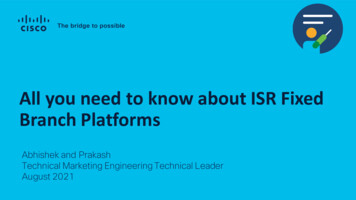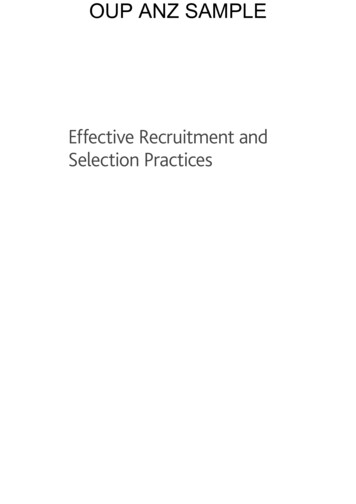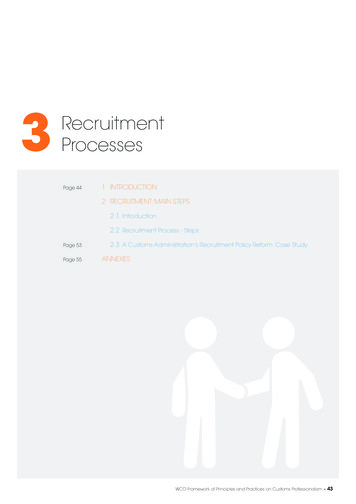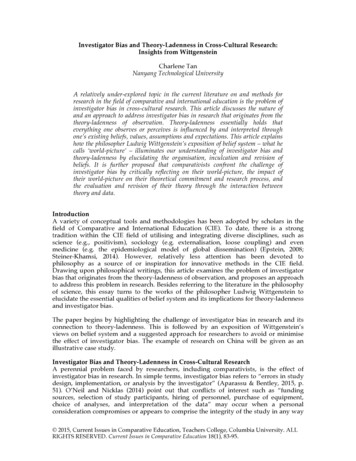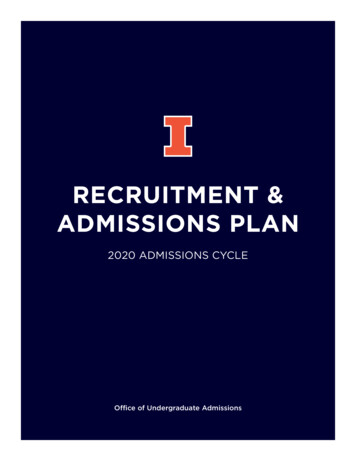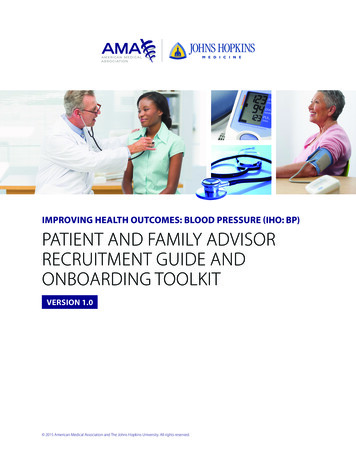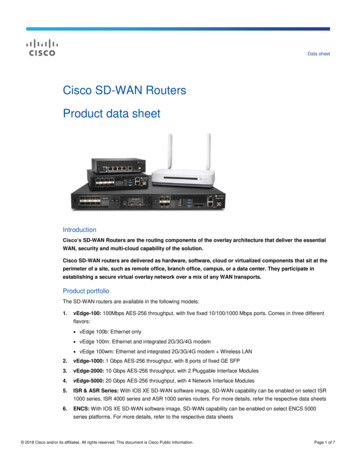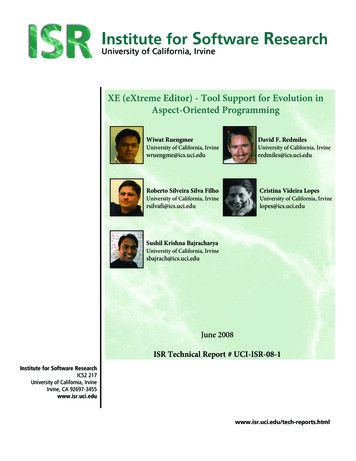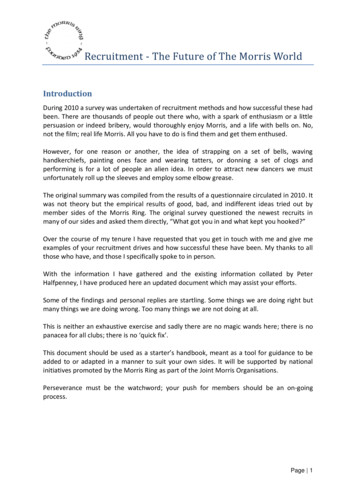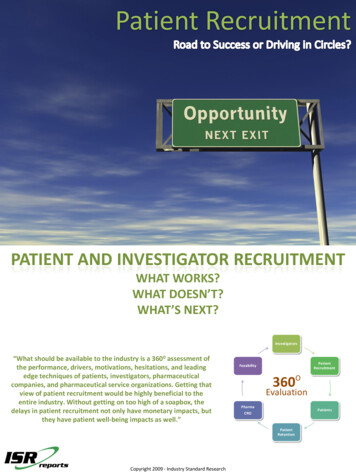
Transcription
Patient RecruitmentPATIENT AND INVESTIGATOR RECRUITMENTWHAT WORKS?WHAT DOESN’T?WHAT’S NEXT?Investigators“What should be available to the industry is a 3600 assessment ofthe performance, drivers, motivations, hesitations, and leadingedge techniques of patients, investigators, pharmaceuticalcompanies, and pharmaceutical service organizations. Getting thatview of patient recruitment would be highly beneficial to theentire industry. Without getting on too high of a soapbox, thedelays in patient recruitment not only have monetary impacts, butthey have patient well-being impacts as nPharmaPatientsCROPatientRetentionCopyright 2009 - Industry Standard Research
THE PATIENT AGE**NO, THIS IS NOT A CRF QUESTIONIf you are at all familiar with the clinical development industry, then you already know the figures: According to the Tufts Center for the Study of Drug Development, less than 10% of clinical development studiesare completed on time. CenterWatch has reported that roughly 70% of all trials are delayed from one to six months due to patientenrollment problems. Delays in the drug development process cost pharmaceutical companies billions of dollars per year. Forexample, a conservative estimate on lost sales per day in the United States would equate to 2.2M.(www.drugs.com reports that in the U.S. in 2007 the 50th best-selling drug (Actonel) generated 2.2M in sales per day) According to a citation at www.ciscrp.org, the number of active investigators in the US has declined 3.5% annuallysince 2001, whereas active investigators outside the US has increased 13.5% each year during that same period.(Getz, Zuckerman and Rochon, “Landscape changes highlight growing challenges for clinical research sponsors” 2009)Index (100 2003)The industry knows the issue at hand – it is not new and it is not solved. Read the press releases, study the magazineheadlines, or look at what companies are exhibiting at major industry trade shows and it becomes strikingly evident:patient recruitment and retention is an industry issue and many companies have positioned themselves to takeadvantage of this opportunity. And make no mistake, it is an opportunity. The number of trials is growing at a rate farfaster than the population and the range of studies is narrowing making competition for patients real. For-profitcompanies, not-for-profit companies, industry steering committees have all been formed to address this issue/opportunity. The Patient Recruitment Organization Steering Committee was formed in 2009 by companiesrepresenting specialized patient recruitment organizations and CISCRP, a non-profit organization that has beenaround for several years advocating for clinical trial education, are just two such organizations.The four citations at the top of this pageare just a sampling and we had literallyCompounds in Development vs. Population Growthdozens of others we could have used. The140pharmaceutical and pharmaceutical service 2009 Industry Standard ResearchCompoundsindustry does not need to be made aware130of the patient recruitment issue. They needsuggestions on how to solve it. The industry120needs a front-line assessment of howthings work in the physician’s office, what110Indiamotivates patients, how pharmaceuticalUnited Statesservice providers perform, and data on theChina100Japanmost effective techniques for patient0recruitment and retention; it needs a 36090evaluation of the issue.20032008More studies competing for relatively fewer patients.Copyright 2009 - Industry Standard Research2
PROOF POINTSImportance of patient recruitmentFrom our own analysis we have discovered the power of askingthe right questions. The information on the right is taken fromour inaugural CRO Benchmarking report released in March 2009(www.ISRreports.com). This report, which analyzed theresponses of 160 pharmaceutical and biotech clinicaldevelopment decision-makers, highlighted some of the veryissues we have previously discussed. Their preference to speedthe patient recruitment process by 10% over receiving a 20%price reduction on a study makes sense perfect economic sense(remember the 2.2M of lost sales per day), however the factthat nearly 90% of people felt the same way confirmed for usthat patient recruitment and retention is one of the burningissues for the industry.Please indicate your preference for one benefit over the other.Would you prefer: (Base all respondents)100%88%80% 2009 Industry Standard Research60%40%20%12%0%20% lower cost of a Phase II/III studyReaching patient recruitment goals 10%faster within the studyPerformance assessmentPatient and Investigator Recruitment Success1 2009 Industry Standard omewhat Fell Shortof ExpectationsPatient and Investigator Recruitment Success – Perception as Market Leader50%39%40%30% 2009 Industry Standard Research20%15%10%1% 1% 0% 0% 0% 1%4% 3%6%13%8%2% 3% 2% 2%1%0% 0% 1%Copyright 2009 - Industry Standard ResearchNoneDon't REXELPPDKendleICONi3 hink about all of the inputs and contingencies that would gointo assessing the performance of patient recruitment. Simplyevaluating whether the number of patients recruited tracks to atimeline might be too simplistic a measure. You have to askyourself, how was the timeline created in the first place, whowas involved, and what processes/ rigor did they follow? Oftenthere are a multitude of very distinct parties involved in theend-to-end patient recruitment process: The sponsor who developed the protocol One or more parties who conduct feasibility studies One or more organizations or departments that select the sitesand principal investigators One or more parties who determine the patient recruitmentstrategy One or more parties execute the patient recruitment strategy.Then we wait. As studies show us, there will most likely bedelays in patient recruitment, but why? Unraveling thecomplexities to answer the “why” question is necessary toimproving the entire process.(0.27) (0.25)(0.28)-0.5Why the underperformance?(0.05)(0.13)(0.15)(0.25)i3 ResearchThe fact that only a few CROs even meet sponsors’ expectationsfor patient and investigator recruitment and that over half ofSomewhat Exceededthe pharmaceutical development decision-makers surveyedExpectationscould not name a market leader in patient and investigatorrecruitment only reinforced the situation. But what about other“service providers” and the pharmaceutical companiesMet Expectationsthemselves, how are they doing?3
COMPLEXITYTrial complexity We don’t think anyone would object to the statement that clinical development studies are more complicated today then theywere five or ten years ago. In fact, Tufts has presented some great statistics illustrating just how much longer trials take and howmany more inclusion and exclusion criteria exist in today’s studies than in years past. Let’s take a look back to what has broughtus to this point. breeds specialization Clinical development has become more complex and has morphed into highly specialized disciplines. Whether it is the innerworkings of a large pharmaceutical company or a combination of the myriad of outsourced service providers, one can find“specialists.” Want someone to provide your IVR? You can find someone? Want someone to manage your EDC? You can findsomeone. Want someone to manage your site start-up? You can find someone. And yes, if you want someone to manage yourpatient recruitment you can find dozens of options. Specialization is not a bad thing and it’s brought about by opportunity arisingfrom missed expectations/ poor performance and robust industry economics. But with specialization comes the addition of manymore moving parts and interested parties. And these numerous moving parts obscure the key inputs that make a clinical trialwork: the physician and the patient. which makes problem identification difficult.So this begs the question: when a statistic is produced that says themajority of clinical studies are delayed due to patient enrollmentproblems, is this due to poor patient recruitment and retention strategyand execution or to poor feasibility and expectation setting? To behonest, we don’t know, but we think someone should start looking into itbecause the ramifications could be game changing for the drugdevelopment industry.Are these easy questions to solve? No. Can we solve it just by talking todrug development organizations? No. Can we solve it by simply talking topatients or potential patients? No. Why not, you ask. Because the issue iscomplex, has many moving parts, and the causal relationships betweenvariables are unknown. As an example, let’s take a somewhat simplehypothetical question: What do you think would impact patientrecruitment and retention more: (1) having a highly motivated principalinvestigator, or (2) a rock-solid patient recruitment and retentionstrategy? Again, we don’t know and we think that some high gainquestions like that need to be 0OEvaluationPharmaWhat should be available to the industry is a 3600 assessment of theperformance, drivers, motivations, hesitations, and leading edgetechniques of patients, investigators, pharmaceutical companies, andpharmaceutical service organizations. Getting that view of patientrecruitment would be highly beneficial to the entire industry andbecause, without getting on too high of a soapbox, the delays in patientrecruitment not only have monetary impacts, but they have patient wellbeing impacts as well.Copyright 2009 - Industry Standard ResearchPatientsCROPatientRetention4
PATIENTS & INVESTIGATORSFeasibilityThe feasibility analysis sets the expectations for the trial and all too often the industry takes it as gospel. Regardless of whethersomeone says a study should take four months or nine months, the fact is it still takes finding qualified and motivated principalinvestigators to participate in a study, making potential trial patients aware of the study, getting them to the clinicalsite, enrolling them, and keeping them engaged until the study completes. However you slice it, more information is neededfrom investigators, site coordinators, and patients before and during a clinical development study in order to ensure that highquality patients are enrolled as quickly as possible and stay enrolled to study completion. According to our sources, the singlelargest complaint from principal investigators (PIs) is that they are not given enough information on which to make an educateddecision; they are asked to comment and give patient recruitment estimates based on very little study information.Ask more questions More information is needed around assessing the rigor (or lack there of) that was undertaken during the feasibility stage ofprotocol development, site selection, and patient recruitment estimations. Some questions that need to be asked include: Were any third party sources of medical data (electronic medical records, prescription drug scripts, HMO claims) used todetermine the potential patient population? Who reviewed the protocol? Key opinion leaders, who may or may not have seen a patient in years, or practicing physicians? Were site selection and patient recruitment estimates gathered in an environment whereby the Principal Investigators didnot have access to the final protocol? How many investigators or site coordinators were given a market research questionnaire to determine their ability to recruitpatients or have interest in participating in the trial? Were patient drivers of study participation and avoidance assessed? How can these be responsibly leveraged / overcome? using more formal methodologies.Most people have heard of the market research technique/ methodologycalled the Voice of the Customer (VOC). We, as market researchprofessionals, strongly believe in the notion that collecting first-handfeedback, suggestions, and barriers from customers is time and moneywell spent. However, VOC works well when you actually know who thecustomer is. And in the end, the customers of the pharmaceuticalcompanies – and by extension, the pharmaceutical services organizations– are: (1) Doctors, Physicians, Clinicians, Investigators and (1) Patients.And “no” we did not make a typo (at least not here) by placing a (1) infront of both Physicians and Patients because we believe both areequally important. What the drug development industry needs is a Voiceof the Patient (VOP) and Voice of the Investigator (VOI) analysis. It is ourhypothesis that if more sponsors, CROs , AROs , and/or patientrecruitment agencies used these 3600 techniques that many of the illsfaced in the recruiting and retaining of clinical trial patients would besolved. We need to triangulate the thoughts, perceptions, andperformance from multiple stakeholders in order to accurately assessthe situation.Would developing processes and techniques to capture the Voice of thePatient and Investigator take more time, resources, planning, andmoney? Yes it would. Would it cost more than a day’s sales? Now that’sunlikely.Copyright 2009 - Industry Standard Research5
WHAT WORKS?WHAT DOESN’T?WHAT’S NEXT?Is patient recruitment and retention one of the most pressing issues for the pharmaceutical industry? Yes.Is that finding industry-changing? No.The drug development industry does not need another analysis that identifies patient recruitment and retention as ahigh-priority issue. What we need is an analysis of what to do next to solve the problem or at least how to frame theright questions. At its essence the problems of patient recruitment and retention could be greatly improved if we, asan industry, could answer the following three questions:11. What methodologies are having the greatest impact and which organizations are performing the best?22. What are the motivations and barriers for patients and investigators to participate in clinical trials?33. What are the best and leading edge techniques?In the end, this is complicated, but oh-so-full of opportunity. Just imagine the possibilities for the organization thatcracks the code and can guarantee patient recruitment and retention schedules. That is game-changing. .www.ISRreports.cominfo@ISRreport.comCopyright 2009 - Industry Standard Research6
the patient recruitment process by 10% over receiving a 20% price reduction on a study makes sense perfect economic sense (remember the 2.2M of lost sales per day), however the fact that nearly 90% of people felt the same way confirmed for us that patient recruitment and retention is one of the burning issues for the industry.
